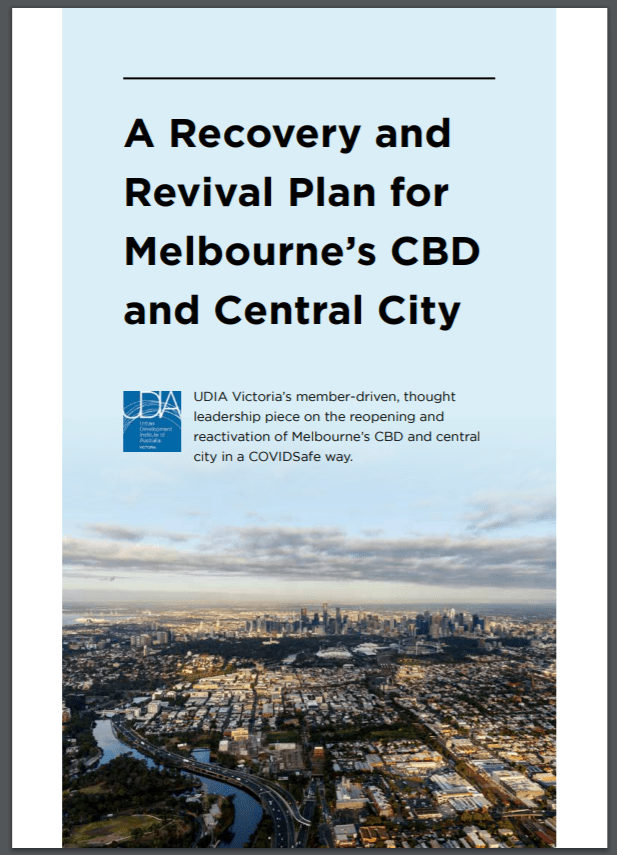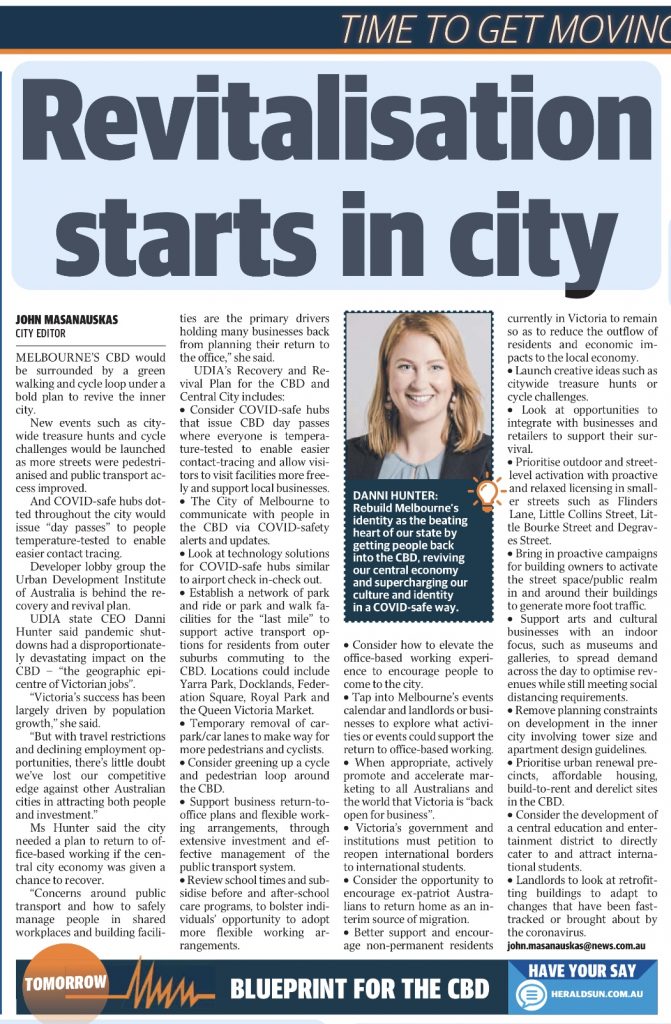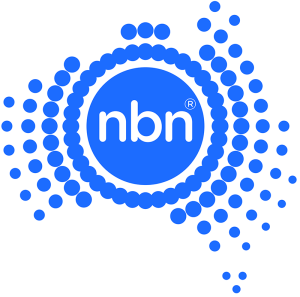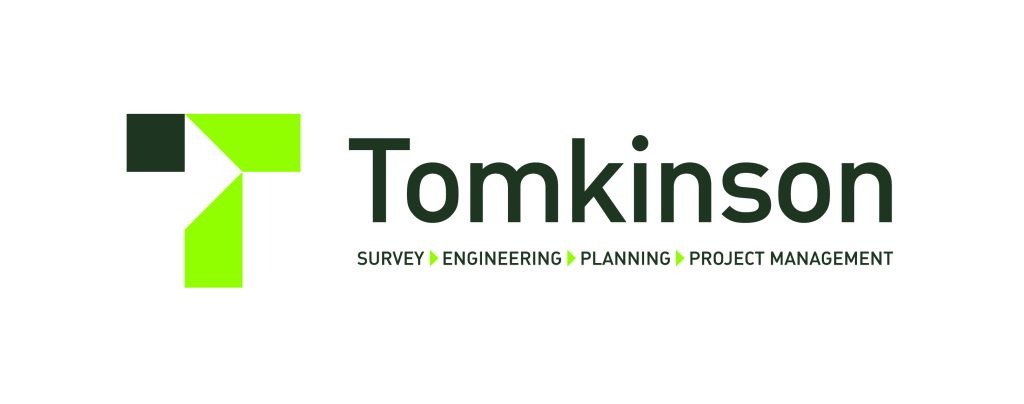Recovery and Revival Plan for Melbourne’s CBD and Central City
Our member-driven, thought leadership piece on the reopening and reactivation of Melbourne’s CBD and central city.

We need a bold, proactive plan to bring our city back to life.
Victoria’s COVID-19 recovery depends on bringing our CBD and central city back to life. We need the people, jobs and economic activity that our amazing city has in spades to supercharge our recovery.
This is UDIA Victoria’s member-driven, thought leadership piece on the reopening and reactivation of Melbourne’s CBD and central city, in a COVIDSafe way.
Click here to access the Recovery and Revival Plan for Melbourne’s CBD and Central City.
OVERVIEW
UDIA Victoria’s visionary strategy to reactivate the city sets out six areas requiring action from both government and mid-large sized businesses.
- Build confidence and trust
Government must adjust the public discourse to focus on how we will live with the virus, rather than only plan for the highly ambitious task of total elimination This is needed to restore overall public and community confidence and empowerment as we look to reopen.
- Increase transport capacity and safety
A whole-of-network approach to public transport must be adopted to increase the capacity and safety of public, active and vehicular transport networks.
- Return to office-based working
Big business must take a leadership role in bringing their workers back to the city at the appropriate time. A commitment from business leaders and CEOs to be proactive in this effort will determine the success of this initiative.
- Open borders to support short- and long- term immigration
The Victorian Government needs to advocate for the responsible and appropriate reopening of national and interstate borders, plus consider interim sources of migration such as ex-patriot Australians returning home.
- Reinvent and leverage Melbourne’s event calendar
We must add new events to the calendar with a focus on driving foot traffic in the Melbourne CBD and accommodating dispersed activity. For example, city-wide treasure hunts or cycle challenges.
- Supercharge built form opportunities
We can unlock Melbourne’s potential competitive advantage by proactively pursuing built form development opportunities to position Melbourne as the ‘Project Capital’ of Australia.
MEDIA RELEASE
Bold plan for Melburnians to live and work with virus
A proactive return to office-based work, a socially distanced events calendar, and the homecoming of ex-patriot Australians are just some of the bold ideas proposed by the Victorian Division of the Urban Development Institute of Australia (UDIA Victoria) in its Recovery and Revival Plan for Melbourne’s CBD and Central City, released today.
“COVID-19 shutdowns have had a disproportionately devastating impact on Melbourne’s CBD and central city, which is the geographic epicentre of Victorian jobs,” said UDIA Victoria chief executive Danni Hunter.
“Victoria’s success has been largely driven by population growth. But with travel restrictions and declining employment opportunities, there’s little doubt we’ve lost our competitive edge against other Australian cities in attracting both people and investment,” said Ms Hunter.
“We need a bold, proactive plan to bring our city back to life – things like staggered office hours, supported by alternate school times and a revised public transport schedule to make that happen safely.”
UDIA Victoria’s visionary strategy to reactivate the city sets out six areas requiring action from both government and mid-large sized businesses.
- Build confidence and trust
Government must adjust the public discourse to focus on how we will live with the virus, rather than only plan for the highly ambitious task of total elimination. This is needed to restore overall public and community confidence and empowerment as we look to reopen.
- Increase transport capacity and safety
A whole-of-network approach to public transport must be adopted to increase the capacity and safety of public, active and vehicular transport networks.
- Return to office-based working
Big business must take a leadership role in bringing their workers back to the city at the appropriate time. A commitment from business leaders and CEOs to be proactive in this effort will determine the success of this initiative.
- Open borders to support short- and long- term immigration
The Victorian Government needs to advocate for the responsible and appropriate reopening of national and interstate borders, plus consider interim sources of migration such as ex-patriot Australians returning home.
- Reinvent and leverage Melbourne’s event calendar
We must add new events to the calendar with a focus on driving foot traffic in the Melbourne CBD and accommodating dispersed activity. For example, city-wide treasure hunts or cycle challenges.
- Supercharge built form opportunities
We can unlock Melbourne’s potential competitive advantage by proactively pursuing built form development opportunities to position Melbourne as the ‘Project Capital’ of Australia.
Key statistics
- Australian Bureau of Statistics (ABS) payroll jobs data shows that inner Melbourne had a 10.3% reduction in jobs from March to August – the worst affected area in Australia.
- The latest ABS labour force data shows that Victoria’s unemployment rates increased from 6.8% in July, to 7.1% in the month of August – higher than the national average.
- The City of Melbourne expects daily visitation in 2020-21 to decrease to 64% of pre-COVID-19 figures and a survey shows 7.5% of food businesses have closed permanently, with a further 8% considering closing.
- With our international and interstate borders closed, one in every 10 homes in Melbourne’s CBD is sitting vacant as a result of the pandemic.
OPINION
Melbourne’s CBD needs an innovative approach to successfully live and work with the virus
Written by: Danni Hunter, UDIA Victoria CEO, October 2020
Melbournians have proven their resilience, determination and drive over the past six months. Lockdown has challenged our businesses, our families and the identity of our city. We are going to need every ounce of innovation, creativity and commitment to plan and execute the recovery and revival plan ahead.
The Victorian Government’s $3 billion business relief package will buy many businesses extra time as they progress through the roadmap to reopening. Sizeable cash grants and tax deferrals provide support to hang in there a little longer. But it is the support dedicated to helping businesses adapt to ‘COVID normal’ that will have the greatest impact when it comes to rebooting Victoria’s economy. The City of Melbourne’s draft Recovery Plan builds on this idea, and shows that together, we will need to learn how to safely live and work with the virus moving forward.
When we talk about the impact of COVID-19 on Victoria’s economy, we must look at Melbourne’s CBD and central city, which is the geographic epicenter of Victorian jobs. Australian Bureau of Statistics (ABS) payroll jobs data shows that inner Melbourne had a 10.3% reduction in jobs from March to August – the worst affected area in Australia.
In 2019, the local economy of our great global city was over $100 billion. More than 500,000 people came to work in the central city every weekday. The latest ABS labour force data shows that Victoria’s unemployment rates increased from 6.8% in July, to 7.1% in the month of August – higher than the national average. The coronavirus pandemic has decimated the local economy and activation of the CBD, with the Melbourne economy predicted to suffer the single largest economic contraction of all Australian capital cities.
The City of Melbourne expects daily visitation in 2020-21 to decrease to 64% of pre-COVID-19 figures and asurvey shows 7.5% of food businesses have closed permanently, with a further 8% considering closing. The city’s residential population is highly reliant on a migrant population including international students and people on work visas. With our international and interstate borders closed, the vacancy rate in the Melbourne CBD is projected to have increased significantly to 10% in September 2020, from 2.8% in February 2020. That’s one in every 10 homes in Melbourne’s CBD sitting vacant as a result of the pandemic.
Rising unemployment, coupled with travel restrictions, will continue to severely compromise our competitive edge against other Australian cities in attracting both people and investment. There’s little doubt the economic impact from job losses, reduced migration, tourism and consumer spending will be immense.
The time for deliberate, bold, proactive and collaborative action is now. Because when we reactivate the Melbourne CBD and central city, we will breathe life back into our state’s primary employment and economic hub and in doing so, our whole state will reignite.
Many businesses responded to coronavirus by shifting to work from home arrangements. This is particularly the case for big businesses who, for the most part, have continued to encourage or mandate employees work from home. The current Stage 4 restrictions mandate that people cannot work from the office, and it is unclear when the Victorian Government will change these specific restrictions. However, we need a plan to return to office-based working if Melbourne’s CBD and central city economy is to be given a chance at recovering.
Concerns around public transport and how to safely manage people in shared workplaces and building facilities are the primary drivers holding many businesses back from planning their return to the office. As such, the return to office-based working for the majority of big business is not on the cards for 2020.
Anecdotally, many individuals are eager to return to the office but do not feel comfortable commuting on public transport. An ABS Survey conducted in late May indicated that 86.3% of Australian workers were ‘somewhat uncomfortable’, or ‘uncomfortable’ using public transport in light of COVID-19. It is clear that businesses need support and a clear plan to guide them through the return to office-based working, and that includes proactive and immediate action to increase capacity and safety of the whole transport network.
We cannot ignore the public health challenges which we will be living with for some time. To effectively support businesses plan their return to the office and flexible working arrangements, we will need extensive investment and effective management of the public transport system, and bold ideas such as staggered school times and before and after school care programs, or the introduction of COVIDSafe Hubs around the city; bolstering the ability and confidence people have as they return to work and play in CBD and central city.
With clear government and private sector policies on how we manage to live and work with the virus, businesses will be able to plan their return to CBD and central city. Big business must take a leadership role in bringing their workers back to the city at the appropriate time. A commitment from business leaders and CEOs to be proactive in this effort will greatly assist the revitalisation of Melbourne’s CBD economy, and our state’s economy.
Learning to live and work with the virus will be key to bringing people back to Melbourne’s CBD and central city, and to how successfully our state recovers from this extended lockdown. We all share the responsibility to come up with a plan, to innovate and implement practical solutions to get people back to our city, and our state back to its former glory.
It will only be when people return to our city, that Melbourne will be able to recover and reignite this critical part of our state economy. There is no greater challenge, nor a more important endeavor on our roadmap to recovery.
UDIA Victoria is a member of the City of Melbourne’s Economic Recovery Advisory Board and plays a lead role in informing and advising all levels of government on policy responses to COVID-19 on behalf of the urban development industry.
– ENDS –
MEDIA CONTACT
Hyatt Nidam
Engagement and Communications Manager, UDIA Victoria
T: 03 9832 9600
M: 0478 415 105











